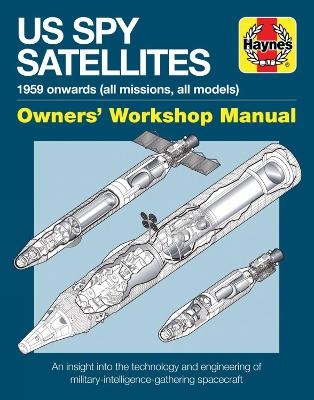
US Spy Satellite Owners' Workshop Manual
J H Haynes & Co Ltd (Verlag)
978-1-78521-086-0 (ISBN)
- Titel ist leider vergriffen;
keine Neuauflage - Artikel merken
Dr David Baker worked with NASA on the Gemini, Apollo and Shuttle programmes between 1965 and 1990. He has written more than 100 books on space flight and military technology and is the former editor of Jane’s Space Directory and Jane’s Aircraft Upgrades. In 1986 he was made a member of the International Academy of Astronautics by NASA manned flight boss George Mueller and is a member of the US Air Force Association and The Association of Former Intelligence Officers. He received the 1998 Rolls-Royce Award for Aerospace Journalist of the Year and in 2005 he was a recipient of the Arthur C Clarke Award. David is currently the editor of Spaceflight, the monthly space news magazine of the British Interplanetary Society, of which he is a Fellow.|The post-war requirement for intelligence on Soviet activities, surveillance versus reconnaissance, and tactical imagery and strategic requirements
Early ideas for spy satellites and the Keyhole series of camera systems and development of satellites up to the KH-8 Gambit series first launched in 1963.
A full description of the plans behind this US military space station, the Manned Orbiting Laboratory, which would have used Gemini spacecraft and a massive telescope to obtain very high resolution images.
The digital direct-transmission KH-9 Hexagon is described in detail as is the integration with the Shuttle and plans for a military Shuttle launch base.
The digital electronic transmission of images from the KH-11 Crystal totally transformed the way intelligence was gathered from space-based assets. A discussion of the KH-11, explaining its function and its use today.
Imaging using synthetic-aperture radar, which can see through cloud and dense fog. This is still a highly classified area.
The infrastructure and roles of the National Reconnaissance Office, the National Security Agency and the National Geospatial-Intelligence Agency.|In 1954, three years before the launch of Sputnik 1, the world's first satellite, top-secret discussions were held in the United States to plan the development of military spy satellites, designed to obtain detailed photography of the Soviet Union's military strength, and its potential for waging nuclear war. This book takes a detailed look at the programmes which resulted from the clandestine decision in the US to build highly secret spy satellites in parallel with civilian space plans, revealing for the first time previously classified details of the design and layout of photographic reconnaissance (spy) satellites including the Manned Orbiting Laboratory (MOL), America's planned military space station. The author has obtained declassified material, lifting the veil of secrecy covering exactly what spy satellites are, how they operate, what their limitations are and what they look like. This book focuses on the development of the spy satellites themselves and on the political arena in which their successes, and failures, were played out, providing a fascinating insight into a secretive world.
Dr David Baker worked with NASA on the Gemini, Apollo and Shuttle programmes between 1965 and 1990. He has written more than 100 books on space flight and military technology and is the former editor of Jane’s Space Directory and Jane’s Aircraft Upgrades. In 1986 he was made a member of the International Academy of Astronautics by NASA manned flight boss George Mueller and is a member of the US Air Force Association and The Association of Former Intelligence Officers. He received the 1998 Rolls-Royce Award for Aerospace Journalist of the Year and in 2005 he was a recipient of the Arthur C Clarke Award. David is currently the editor of Spaceflight, the monthly space news magazine of the British Interplanetary Society, of which he is a Fellow.
*The post-war requirement for intelligence on Soviet activities, surveillance versus reconnaissance, and tactical imagery and strategic requirements.*Early ideas for spy satellites and the Keyhole series of camera systems and development of satellites up to the KH-8 Gambit series first launched in 1963.*A full description of the plans behind this US military space station, the Manned Orbiting Laboratory, which would have used Gemini spacecraft and a massive telescope to obtain very high resolution images. *The digital direct-transmission KH-9 Hexagon is described in detail as is the integration with the Shuttle and plans for a military Shuttle launch base. *The digital electronic transmission of images from the KH-11 Crystal totally transformed the way intelligence was gathered from space-based assets. A discussion of the KH-11, explaining its function and its use today. *Imaging using synthetic-aperture radar, which can 'see' through cloud and dense fog. This is still a highly classified area. *The infrastructure and roles of the National Reconnaissance Office, the National Security Agency and the National Geospatial-Intelligence Agency.
| Erscheinungsdatum | 28.09.2016 |
|---|---|
| Zusatzinfo | 300 Illustrations, unspecified |
| Verlagsort | Somerset |
| Sprache | englisch |
| Maße | 210 x 270 mm |
| Gewicht | 831 g |
| Themenwelt | Sachbuch/Ratgeber ► Freizeit / Hobby ► Modellbau |
| Natur / Technik ► Fahrzeuge / Flugzeuge / Schiffe ► Luftfahrt / Raumfahrt | |
| Technik ► Elektrotechnik / Energietechnik | |
| Technik ► Fahrzeugbau / Schiffbau | |
| Technik ► Luft- / Raumfahrttechnik | |
| Technik ► Nachrichtentechnik | |
| ISBN-10 | 1-78521-086-6 / 1785210866 |
| ISBN-13 | 978-1-78521-086-0 / 9781785210860 |
| Zustand | Neuware |
| Haben Sie eine Frage zum Produkt? |
aus dem Bereich


